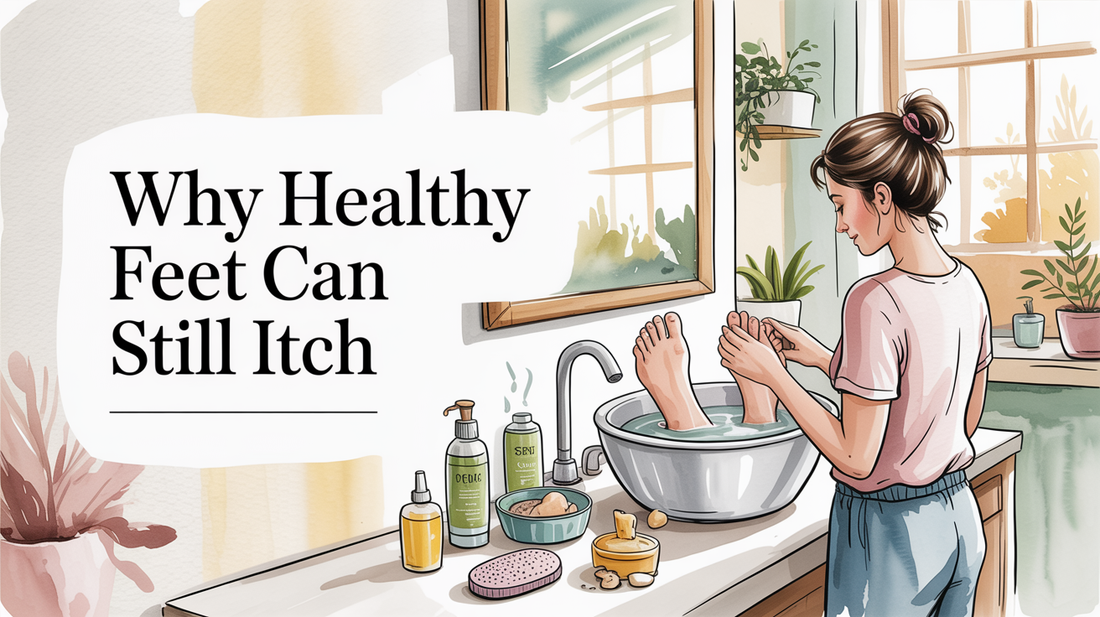Why do healthy-looking feet still itch?
itchy feet, hidden fungus, contact dermatitis — If you’ve ever experienced the frustration of itchy feet that look perfectly fine, you’re not alone. Understanding the underlying causes, such as hidden fungus and contact dermatitis, can help you address these pesky sensations. This post is organized into three clear sections, offering insights and practical tips to help you take action tonight.
Irritant vs infection 🧭
Understanding the difference between irritant contact dermatitis and fungal infections is essential for addressing itchy feet that appear healthy. Irritant contact dermatitis arises from reactions to harsh chemicals, soaps, or materials, leading to inflammation without any infection. In contrast, fungal infections are caused by tiny organisms that thrive in warm, moist environments and may be present even when your feet look normal.
Contact dermatitis often results in redness, burning, and itching, but typically lacks scaling or peeling. Fungal infections might begin subtly with mild itching before any visible symptoms show. It's also useful to know that irritants can include harsh soaps and synthetic materials, while fungal spores might remain dormant on seemingly healthy skin until conditions become favorable.
- Contact dermatitis is marked by redness and burning without peeling.
- Fungal infections can start with mild itching before becoming noticeable.
- Irritants like soaps and dyes in socks may trigger reactions.
- Fungal spores can lie dormant on healthy skin.
- Itching between toes might suggest fungus, while itching on the top of the foot may indicate contact irritation.
Try It Tonight: Calm, Fresh Feet ✨
- Wash your feet with warm water and a mild cleanser; ensure you dry thoroughly between your toes.
- Apply a small amount of Kissable Feet where needed; massage until absorbed.
- Let your skin breathe; slip on breathable socks if desired, but patch-test first if you’re new to this foot cream.
Moisture traps ✨
Moisture traps can create perfect breeding grounds for fungal growth, leading to persistent itching even when your feet appear healthy. These hidden pockets of dampness allow fungi to thrive while remaining undetectable. Being aware of and eliminating these traps is key to resolving chronic foot itching.
Tight-fitting shoes, for instance, can create enclosed environments where sweat cannot evaporate properly. Similarly, synthetic sock materials can trap moisture against your skin, unlike breathable natural fibers. Pay attention to the spaces between your toes, which can collect moisture, especially if your toes are closely spaced.
- Wear shoes that fit well and allow airflow to prevent moisture buildup.
- Choose socks made from breathable, natural fibers rather than synthetic materials.
- Ensure thorough drying of your feet after showering, especially between the toes.
- Be cautious of public shower floors and gym mats that can harbor fungal spores.
- Practice good foot hygiene by drying all skin folds and nail beds thoroughly.
Why We Recommend a Gentle Helper 🌿
Kissable Feet is designed for quick absorption and provides a soothing, non-sting feel. This nurse-crafted blend features tea tree, coconut, and calendula, offering comfort and a clean finish that's easy to integrate into your nightly routine.
- Fast-absorbing comfort with a non-greasy finish.
- Gentle sensation suited for sensitive, overworked feet.
- Clean, bedtime-friendly scent.
When to try antifungal 🔍
Knowing when to consider antifungal treatment for seemingly healthy but itchy feet involves understanding specific signs and risk factors. Many fungal infections start with subtle symptoms before any visible signs emerge, making early intervention vital for preventing further issues.
Look out for persistent itching lasting more than two weeks, especially if hygiene and moisture control don't seem to help. Conditions that worsen in warm, humid environments or after long periods in closed shoes can also indicate a fungal issue. Additionally, a history of previous fungal infections, diabetes, or a compromised immune system can increase susceptibility.
- Persistent itching that lasts more than two weeks despite hygiene efforts.
- Increased itching in warm, humid conditions or after wearing closed shoes.
- A personal or family history of fungal infections can heighten risk.
- Itching that accompanies subtle changes like skin thickening or minor scaling.
- Recent diagnoses of fungal foot infections within close contacts.

